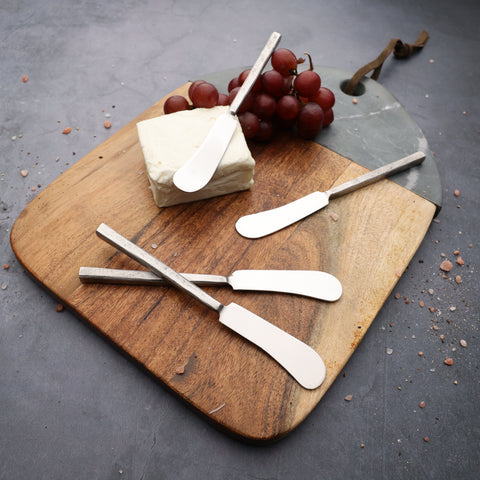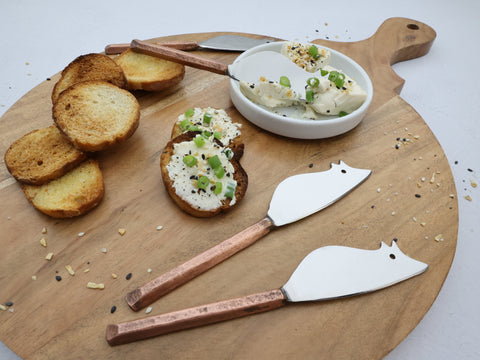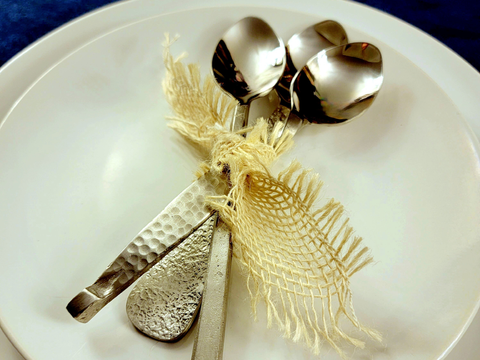When a table is beautifully set, everything invites you to pause, connect, and enjoy the moment. This is what we mean by fine dining; it's a different experience than merely amazing food, it includes an atmosphere in the thoughtfulness of how everything is set. It is difficult to not feel somehow a little formal when you see a complete set of gleaming flatware available. However, each piece is less about passing the final exam, and instead, a key designed to unlock a more fluid and graceful way of enjoying your meal. Getting into this space is not about strict rule memorization, but other, then not to enter a very mindful state of which you are respecting the occasion, the creativity of the host, and the ability to be present.
Let's turn our attention to one of the most upbeat utensils in this environment, the butter knife. More likely than not, the butter knife is the first utensil that you will use. So, if there is even a hint that you want to establish a tranquil confidence in your intentions for dining, if you use the butter knife, then you have unlocked a full range of potential to establish that tone for the evening. Now settle into the fact it is not an exam for you to pass your dining etiquette.
The Character the Butter Knife
The butter knife stands out from other cutlery in the placement of its use: it is clearly not meant to cut or slice (for that, the table knife must be enlisted). Rather, it occupies a place of respect—positively tranquil—at the table because of how it functions; it vanishes once someone creates space for anything else. To fully recognize the significance of butter as a condiment within modern dining culture, it is best for the butter knife to be properly understood, meaning it must first be recognized for its missing form. Admittedly, the butter knife is a splendid invention, a masterpiece of functionalism (notice its shorter stature, the butter knife has a smooth, rounded blade, completely dull at the tip, and created to glide and spread—not cut or pierce).
In many well-appointed flatware settings, you will encounter two distinct but related knives for the bread course, a nuance that is the hallmark of sophisticated hosting.
- The Master Butter Knife: This is the communal knife, a slightly larger in size knife that compliments the butter dish. This knife has a single purpose - to serve. It is the connection between the communal butter and your plate.Its presence signals a thoughtful, hygienic approach to service.
- The Place Spreader: This is your butter knife. It is smaller than the master knife and is included in your individual place setting. This is the utensil you will use in the course of the bread course. The best silverware brands excel because they balance and feel of the place. Whether it is made from traditional stainless steel flatware, or is completed in black flatware finish, the craftsmanship is important. Just look at the Ridge collection as shown here - the place spreaders add an interesting modern architectural texture on the handle that turns this simple utensil into a functional sculpture.
The brilliance of its mild demeanor and design comes through in use. The rounded tip ensures soft dinner rolls won't suffer accidental tearing, and the flat blade is form-fitted to hold and apply the right amount of butter in one, smooth, clean stroke.

The Art of Placement and Presence
The concept of a well-set table is both rational but beautiful - in fact, it is one of the few times in life where we get to choreograph a space for dancers, each with their own place. Your bread plate will always rest on the upper left side of your dinner plate. This is an easy placement, as it consists of two important considerations. The first consideration is that it will keep it out of the way of your main plate. The second consideration is to clear a space on your right side for your glassware. The bread plate will also be the home for your butter knife.
The knife will always rest horizontally along the top edge of your bread plate. As is typical of polite and safe behavior, the soft blade should always point inward towards you. This thoughtful disposition during your dinner table settings is a way to keep your table uncluttered and present your knife for making the first cut into your bread and starts the meal with grace and thoughtfulness. While the bread course is a staple in the American fine-dining experience, there are applications - as seen in some formal fine-dining traditions in Europe - that might, for example, place the bread directly on the tablecloth, but that do not stray from using the principle of having a designated knife or spreader to serve the butter.
A Complete Guide
The etiquette for butter knife use has a simple, yet thoughtful rhythm. Once the steps are learned, they simply become an easy and instinctive part of your dining style.
- The Communal Transfer: The ritual commences with the master butter knife. When the dish of butter is brought to your table, it is at that point that you will use the shared utensil to take one small pat of butter for yourself, enough that it would be suitable for coating a slice or two of bread. Select a reasonable area on your dinner plate, preferably an area near the upper edge of the plate to avoid placing it on the bread. Then, after you have executed that single motion, you may replace the master knife back to the butter dish for those who will come after you.
- Breaking Bread: A regulatory principle of dining etiquette is that you never butter an entire slice of bread at one time. Instead, you should take your hands and break off a piece from the dinner roll or slice of bread you are utilizing, just one small bite size piece. Breaking bread is not only proper dining-to-go etiquette, but it also helps regulate a meal to be eaten slower, be mindful about what you are eating, and keep your eating space free of crumbs that accumulate from cutting your bread often.
- The Time for the Spreader to Rest: After you butter that small piece of bread, put the spreader back onto your bread plate. It can stay on your plate horizontally or angled slightly to the side. Never place it on your main dinner plate or the tablecloth. You will go through this fluid cycle of tearing a piece of bread, buttering that piece, and eating that piece multiple times throughout the meal.
The Versatility of the Spreader
Though it is called a butter spreader, the elegance of the place spreader is much wider than just butter, making it one of the most essential implements of a well-rounded piece of tableware.
The gentle design makes it the perfect tool for substantial soft foods. When enjoying a cheese course with softer, creamier cheeses like brie, chèvre, or mascarpone, your spreader will absolutely suffice in place of a purpose-built spreader from a cheese set, for instance, the cute Ratoncito mouse-shaped cheese spreader which always adds some whimsical artistry to a table.
And, the spreader works much the same way during cocktail parties or while having appetizers. It is the best tool for taking fine soft pâtés, rillettes, mousses, and the like from a serving board or platter, i.e. a charcuterie board. Providing each guest their own spreader, makes one a sophisticated host. Just imagine a beautiful wooden board with cheeses and pâtés stacked on it, with a number of spreaders waiting to be used, maybe even the rustic, yet refined, Antler spreaders.
FAQs
-
Why shouldn't I butter an entire slice of bread at once?
Instead of buttering the whole slice of bread at once, buttering piece-sized bits only is a cleaner, more controlled, experience. It avoids a potential mess of crumbs, eliminates the awkward situation of holding the larger buttered piece of bread, and additionally helps you control your meal pace and your ability to socially converse. -
What if I am not provided a butter knife?
In a more relaxed setting, it would be completely modern to butter with your everyday knife. But if you are in a formal context and there is a butter knife in the place settings, you should always take the butter knife provided as it was meant to be used and your everyday `dinner knife` is only for the main course. -
Would a nice set of flatware be a great gift for housewarming or a wedding gift?
Yes! A full set is a traditional gift that has never gone out of style. However, if you wanted to make an extra special gift, consider a specific set such as a full set of cheese knives. An attractive collection such as the Stingray collection with shagreen-textured handles, would certainly become a collective wedding registry gift, but ultimately a family heirloom to be treasured in a new couple's home.
Where does the butter knife go when the meal is over?
Your personal butter knife should remain on your bread plate. When the staff clears the table after the bread course, or between the main course and dessert, the bread plate and the knife will be taken away together.



